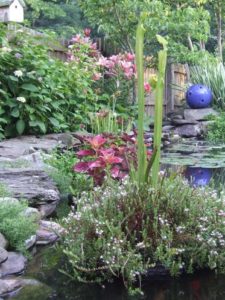By Max Phelps
Fruiting shrubbery and flowers can be used in landscaping a water feature just as easily as using traditional shrubs or grasses, and can look just as amazing. You’re going to landscape your waterfall and pond, so why not do it with edible trees, shrubs and groundcovers? Here are some that work well for me, but I am sure there are others.
Let’s start with a serviceberry (amelanchier), either a tree form or a clump. Let’s locate it to sort of lean towards our waterfall or stream. We’ll get lovely white blooms in March, and juicy fruit in June if we beat the birds to it. (You can’t say that about a crepe myrtle or a Japanese maple.)
If the water feature is out in the yard and away from big trees, away from any woodland, I always want to add at least one small tree as I landscape it. Ideally, positioned to keep part of the day’s sunlight off the stream or pond, which will help with low oxygen and algae problems. Besides the sarvis, Saskatoon, shadbush or service berry, (depends on where you’re from) what other trees that bear food would work for that one (or two or three!) tree you plan to put in the waterfall or water garden landscape?
I’ve used pawpaws, they resemble a deciduous magnolia. You need two in a clump or another tree in the yard somewhere for good pollination. A quince or a dwarfish apple could work. A simi-dwarf self-fruitful cherry or a cornelian cherry dogwood would be a lovely addition. More exotic options: jujubes, olives, various citrus trees, or a mayhaw or a mountain ash bred for its fruit. Medlar or mulberry—the medlar tasts like apple butter with cinnamon sprinkled on. Do a little checking to see if a plant will live and prosper in your climate as you add fruiting trees around your pond and waterfall. For an evergreen, use Korean nut pine, Swiss stone pine or in the SW United States, the pinyon pine—pine nuts are delicious!
Next, add some shrubs of varying sizes for a naturalized look. I automatically go to the blueberry. There are blueberries that grow from Orlando to Ottawa, from a foot to 8 feet tall, and some keep their colored leaves most of the winter at least in USDA planting zones 7-10. A rather new fruiting bush I highly recommend for zones 3 through 5, and worthy of trial in 6 and 7, is the honeyberry or haskap. I also will use currants, gooseberries, seaberries, bearberries and the upright thornless blackberries. Oregon grape holly is an evergreen that is lovely and has edible
blue berries (even if not too tasty, they are good for you). The right edible shrub in the right location can make for both good landscaping and yummy snacking. (Metaphorically, I always love killing two birds with one stone.)
OK, let’s add a blossom or two. Ever add daylily blossoms to your salad? I prefer them a couple days before the bloom opens myself. They can also be batter dipped and deep fried. In Asian cuisine they are both staple and delicacy. Asparagus, onions, fennel, flowering kale, Swiss chard are all reasonable edible items that look nice in the landscape. And you can always find a way to hide one tomato plant or one hot pepper plant if you don’t want to showcase it.

Finishing our layered naturalizing look, add creeping groundcover plants. Watercress is great in the bog or waterfall box, but cranberries can really naturalize a streambank or pond edge (see photo). Creeping rosemary for zone 7 and southward is wonderful at naturalizing pond edges. Wintergreen (gaultheria), also known as mountain tea or teaberry, is a cute little creeping evergreen for the shade. (Cranberries prefer sun.) Sheep sorrel or oxalis are tasty in a salad and do wonders to naturalize a waterfall edge. Creeping raspberries, lingonberries, kinnikinnick, pineberries and Alpine strawberries would all be naturalizing as well as bear edible fruit.
Now, if you have a fence or some lattice or an arbor near your waterfature, here are some climbers to use. Scarlet runner beans if you want an annual. Passionfruit, magnolia vine, hardy kiwi, hops, ornamental grapes and goji berries all look nice and also fruit. Tasmanian vine for the tropics.
With all these fresh goodies your trips to the produce stand should be reduced a great deal, and the landscaping will be lovely too. Checking to see what’s ready to eat would be extra incentive to get out and enjoy the water feature. Why go with a nandina or a Japanese maple or a boxwood around your pond when you can have a whole food forest to munch on and the most natural looking waterfall in your whole town!